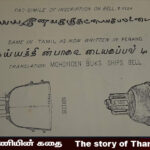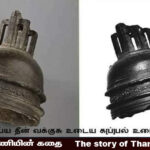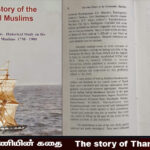

The story of Thamizh mani
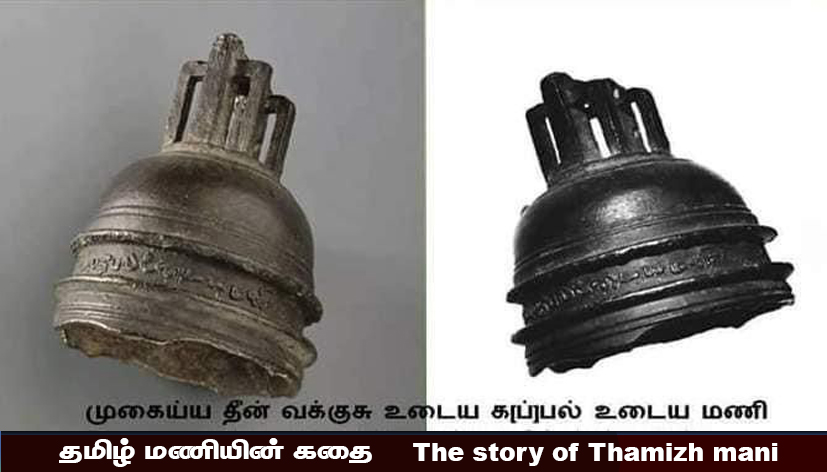
A small, charmed bell with Tamil characters is on display at the National Museum of Wellington, New Zealand and is known as “Thamilmani”. It forms the basis of various stories. Recently I came across a Facebook post about the history of this bell. When I pointed out the historical errors I found in it, the editor later said, “He got this message from the website and posted the same.” It is posted to provide some data about this bell.
When I was doing research for my PhD on the history of maritime trade of Thamil Nadu Muslims in the 1900s, I came across different reports about this bell. So, I started researching this.
As I used to work in the museum sector, I wrote to the National Museum of New Zealand Welling to provide details of this bell. A reply was received from the said museum on 24.05.1990 along with the articles, dissertations, and photographs so far written on the said bell.
The theme of the message is as follows: “The height of this bronze bell is 3 ¾ inches and its diameter 5 ½ inches. The lower part of the bell is broken. On the outer side of the bell, in the middle, there is the inscription “Mugayadeen Vakusu Udaiya Kabbal Udaiya Mani” in a circle. It has total 23 characters. (Thamizh letters23) The characters are embossed rather than cut or engraved in the usual way. So, this text is embossed in ½ inch stroke.”
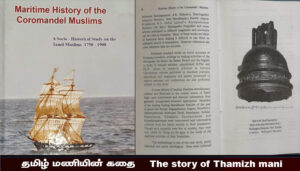
“This bell was first exhibited at the International Exhibition held in New Zealand in 1865 by a Christian Missionary – Reverend Golan Cho. In 1839, the New Zealand Mori people who lived in Wankeri on the New Zealand Island received this bell from the people of New Zealand and said people found this bell from a log lying on the beach. The priest Golan Cho mentioned the news about the bell. The museum records for that year state that the bell was received by the priest Golan So in 1890 to the Wellington National Museum.”
John Crawford, who first wrote about this bell in 1867, said that the writing on the bell was Javanese. However, it was not impossible to read it. The said museum was constantly trying to get correct information about the bell. According to the request of the museum, Professor Selvam was a Tamil Nadu worker who worked at the Asian Studies Institute in Copenhagen, Denmark in 1940. Scott Christian College professor D. Jesuthas in Nagercoil declared it to be Tamil writing and read the appropriate text. They said that it might be a bell found in a ship belonging.
to Mugaiyadeen Vakusu. But it was impossible to know how the bell reached New Zealand shores.”
“In 1975, Robert Langdon and Brett Hilder wrote and published reports on the history of this bell in popular research journals. This bell must have came from the ship of a Muslim merchant and must have been the bell from a ship that came to the ports of Australia for trade from any part of Arabia, India, Sri Lanka, and far eastern countries. They also wrote in their articles that this bell has been found here 50 years after the island of New Zealand was introduced to the outside world. However, there is no complete information available regarding the above bell. Through these articles, the news about the bell is likely to spread throughout the world.” Researchers and Thamilians have different opinions about this bell.
The Sri Lankan Thaninayagam Adikalar, who studied the text of Mani, gave a reading that is more suitable for the Tamil text. He said that it reads as ” Mugaiyadeen Vakkusu’s ship’s bell” was based on handwriting. These writings must belong to the 17th-18th century AD, and it may be the bell of a ship that went out to the Indian Ocean from the coast of Tamil Nadu. Based on the above information, the most important question that arose in my mind was whether Mugaiyadeen Wakkusu is the name of a person or of a ship.
After the publication of such detailed articles in 1975, there were ‘claims’ on this bell from many parts of the world. Struggle for the rights of Sri Lankans, Malayan seamen, Tamil Nadu seamen, and businessmen! It’s a long list. However just a few for your perusal:
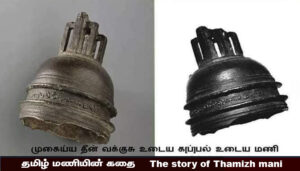
A Tamil mani is exhibited in the New Zealand Museum by A.K. Ribai who wrote the book, History of Tamil Nadu Islam in 1988. It says ‘Mugaiyadeen Adhu’. O.M.S.K. Abdul Karim Marakayar from Marakayar Pattinam, Ramanathapuram District wrote that this bell was obtained from a boat belonging to his family’s ancestors, so it should be handed over to us.
Another voice from the lower shore! “This bell is the ship’s bell belonging to King Urapeepu called Lower Bank Urapeepu Marakayar, who had 40 ships. His ships visited many ports of the world. There is a possibility that this bell may have gone to the area from his ship that went to New Zealand.
A man from Rameswaram wrote a sensational article that ‘Thamizh Muslims are the ones who discovered the island of New Zealand’ because this bell inscribed with Thamil script was found in the island of New Zealand.
Another person from Keezhakarai said, “Our forefathers in Keezhakarai used to do sea trade traditionally. They had many ships of their own. Our family title (typical name) is ‘Wakkaasu’. There is evidence that Mugaiyaideen Wakkasu is the name of one of our ancestors. On the bell is written Mugaiyadeen Wakkusu. So, this mani belongs to our family” and had also published a Jabita through their family flag. (See on the web)
Even today the voices of some seafaring families echoed from the Keezhkkarai shores. With such bundles of information my research journey on “History of Maritime Trade of Tamil Muslims” continued.
I was studying the history of sea trade in the 18th and 19th centuries and the commercial documents left by the British on the contribution of Muslims in the Chennai Archives. During this period, the “names of ships” registered in Nagapattinam, Ramanathapuram, and Thanjavur districts were Kathar Bux, Mohideen Bux, Mohideenn Bhagyalakshmi Bux, Mohammad Sulaiman Bux. The ship owners are mostly Muslims. However, the owner’s name and ship name are different. For example, the owner of a ship named Kathar Bux registered in Nagapattinam in the year 1808 was Mohammad Nainar Marakayar. Thus, it came to be known that Muslim ship owners named their ships after Islamic spiritual leaders. (Tamilnadu Archives, Tanjore District Records Vol. No.3174/31 Mard. 1806; Public consultations vol, 610/9 April/1833; Vol. 614/2 0ctober, 1833; Vol. 636/18 May, 1835; Vol. 666/ 18 April 1837; Tinnlveli Gazette Vol VI. No. 194/December 1862-
This documentary explained a great message to me. In other words, it was learned that ‘Mugaiyadeen Bux’ is the name of a ship, and that is what is written on the said bell as ‘Mugaiyadeen Wakusu’. Also, it was concluded that Bux also means ship.
Next our attention turns to Mani’s claims. I studied the documents related to Ramanathapuram district, knowing that the voice of the lower reaches is important in this. In these documents we can find much news about Gizlakarai Habib Muhammad (King Habib). There were also special reports of him being a shipping merchant in the Cholamandala (East) coast and in Sri Lanka. But there is no information about how many ships he had and whether there was a ship named Mukaiyeddin Bux among them.
Also records indicate that Habibu Marakayaru’s cells had business contacts with East Coast (Tamil), West Coast (Malabar) ports and Sri Lankan sector. There are no records of his ships operating in the Indian Ocean area. So it is clear that this bell does not belong to Habib’s wooden ship
Marakayar place or city and any documentation were not found about Marakayar. No information about ‘Wakasu’ family tradition either in the documents or in the field survey of the area is yet to be known. Think for yourself what a discovery it was that the Thamizh Muslims discovered the island of New Zealand. In this way, many more voices about rights must be silenced.
From Madras Port (Madras Port) in the 18th and 19th centuries, there was direct shipping with the Indian Ocean countries. Timber for East India Company ships from Australian ports to Madras (Chennai) by English Company ships were bought. English Company ships as well as private ships were engaged in maritime trade on this route. Such trade was also carried on from Madras and its nearby ports. In the middle of the 18th century, records show that a ship named ‘ Mukaiyadeen Bux’ sailed from Palavekad (Pulicat) port to Indian Ocean port.
The ship was owned by Mohammed Shabi and a Dutch privateer named Jane de Matu Aquares. This ship’s bell may have washed ashore in the Indian Ocean when the ship ran aground in Australia and nearby New Zealand.
However, I have not found the ship logs of this ship to know the complete news about this. I am still searching. However, our research shows that Mukaiyadeen Bux, which went to New Zealand, is a Tamil Nadu ship. This bell may be from that ship.
In December 1990, I presented a research paper at the Fifth World Islamic Tamil Literature Conference held in Keezakarai. The article has also appeared as a conference proceeding. Subsequently, I have mentioned these messages in several articles.
In my doctoral dissertation ‘Maritime History of Muslims of Coromandel Coast’ published in 2004, I have mentioned the news about this along with the photograph of Mani. Historians of maritime trade worldwide have seen this. (The Tamil version of this English book is coming out soon). I have been correcting the erroneous news about this watch. Go through all the levels just for an overview.
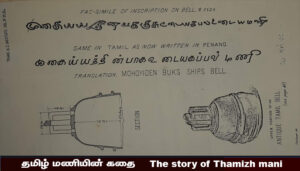
In 1997, I witnessed a photograph of this bell in the National Museum, Delhi with the words, “A 13th century Pandyan bell in a New Zealand Museum”. I wrote them the correct information. The correct information is now there.
Why work at such a time on a ship? Our study of the ship SS Rajula yielded an interesting information. At every meal they would give the boy a bell and ring it to announce that the meal was ready.”
Dr. J. Raja Mohammad, “Rajula, History of 20th Century Ship”. (Book) “Navai – Maritime Historical Studies”, (T.A.) N. Athiyaman, Tamil University, Thanjavur, 2010). Because the bell we are talking about is also small, it may have been intended for such a use.
I was so excited to see this bell. I was full of longing to see this bell someday. In the month of December 2019, I was invited from India to give a paper on “Singapore sea trade relationship of Tamilian Muslims and its effects” at an international historical conference organized by Singapore Indian Heritage Center in Singapore.
The discussion about this bell took precedence. Also, the New Zealand Wellington Museum brought this bell (the original) to Singapore and put it on display. I got a rare opportunity to see the bell that was being circulated in the media all over the world. I posted my opinion on the bell in that forum as well.
Apart from such correct information, the proverbs and stories told by someone at any time are rifled with missing information. Although I have written many such thesis, I still feel that I have not told these messages so that many people know them widely. As I mentioned earlier, the registrant who posted about this mentioned that the news he posted was taken from the website. The web site is the simplest encyclopedia we have in modern times. Great news can be a trap. But it is not to say that all the news coming in this is historical. As anyone can write anything on the internet media, the writer posts that news he knows in a hurry. It becomes the duty of those who read them to know its authenticity. Just be careful when handling them!
One thing that came to my mind because of such situations is that we should continue to tell news like this! Moreover, the history of Muslims is at its peak as fabricated as it can be.So, I feel it is imperative to focus on this and bring out the correct history about us at the end of this post.
Unstirred rice will not cook,
Shaved hair never falls.
Unwashed clothes do not bleach,
Truth that is not explained like these will also be wasted.
Facts in due course for an unexplained reason, Unrighteous people to be able to cling to Aryasana. Arignar Anna said that, flashed on my mind screen.
Let us continue with the historical facts.
